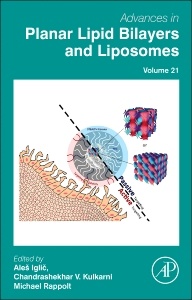Description
Advances in Planar Lipid Bilayers and Liposomes
Directors of collection: Iglič︎ Aleš, Kulkarni Chandrashekhar V., Rappolt Michael
Language: English
Subjects for Advances in Planar Lipid Bilayers and Liposomes:
206 p. · 15x22.8 cm · Hardback
Description
/li>Contents
/li>Readership
/li>Biography
/li>Comment
/li>
The Elsevier book-series "Advances in Planar Lipid Bilayers and Liposomes? (APLBL) provides a global platform for a broad community of experimental and theoretical researchers studying cell membranes, lipid model membranes and lipid self-assemblies from the micro- to the nanoscale. Planar lipid bilayers are widely studied due to their ubiquity in nature and find their application in the formulation of biomimetic model membranes and in the design of artificial dispersion of liposomes. Moreover, lipids self-assemble into a wide range of other structures including micelles and the liquid crystalline hexagonal and cubic phases. Consensus has been reached that curved membrane phases do play an important role in nature as well, especially in dynamic processes such as vesicles fusion and cell communication. Self-assembled lipid structures have enormous potential as dynamic materials ranging from artificial lipid membranes to cell membranes, from biosensing to controlled drug delivery, from pharmaceutical formulations to novel food products to mention a few. An assortment of chapters in APLBL represents both an original research as well as comprehensives reviews written by world leading experts and young researchers.
- Development of Polymer/Nanodiamond Composite Coatings to Control Cell Adhesion, Growth and Functions
- Tethered Phospholipid Bilayer Membranes: An Interpretation of the Electrochemical Impedance Response
- Microscopy of Model Membranes: Understanding How Bcl-2 Proteins Mediate Apoptosis
- Optical Microscopy of Giant Vesicles as a Tool to Reveal the Mechanism of Action of Antimicrobial Peptides and the Specific Case of Gomesin
- Steric Stabilisers for Cubic Phase Lyotropic Liquid Crystal Nanodispersions (Cubosomes)Josephine Y. T. Chong, Xavier Mulet, Ben J. Boyd and Calum J. Drummond
Milena Keremidarska, Kamelia Hristova, Todor Hikov, Ekaterina Radeva, Dimitar Mitev, Ivailo Tsvetanov, Radina Presker, Damjana Drobne, Barbara Drašler, Sara Novak, Veno Kononenko, Kristina Eleršic, Lilyana Pramatarova and Natalia Krasteva
Gintaras Valincius and Mindaugas Mickevicius
Kushal Kumar Das, Joseph D. Unsay and Ana J. Garcia-Saez
Karin A. Riske
The purpose and the scope of APLBL book start from production protocols to methodological and technological developments of lipid nanostructures, their structural, chemical and physical characterization and understanding. Explorations of novel applications have been and are being also covered in this book series. The APLBL book series not only serves as podium for non-specialists working on interdisciplinary front but also retains its special significance for the experts in the field of chemistry, physics and biology of lipid micro- and nanostructures and biological membranes.
Chandrashekhar V. Kulkarni received his PhD in Chemical Biology from University of London for which he was in receipt of a Marie Curie Early Stage Researcher Fellowship at Imperial College London (2005-2008). Earlier he completed his BSc (1999) and MSc (2001) in Chemistry from Shivaji University Kolhapur, India and started his research career at the National Chemical Laboratory Pune, India. He had a few postdoc stints at University of Graz-Austria, University of Bayreuth-Germany and University of Cambridge-UK during which he worked on a wide range of projects. In March 2013 Dr Kulkarni started ‘Lipid Nanostructures Group’ focussing on highly interdisciplinary and cutting-edge projects. Some of his research interests include complex biomembranes and biomolecule interactions, nanostructured lipid
- The APLBL book series gives a survey on recent theoretical as well as experimental results on lipid micro and nanostructures.
- In addition, the potential use of the basic knowledge in applications like clinically relevant diagnostic and therapeutic procedures, biotechnology, pharmaceutical engineering and food products is presented.
- An assortment of chapters in APLBL represents both an original research as well as comprehensives reviews written by world leading experts and young researchers.




